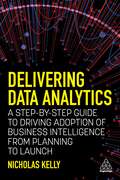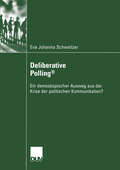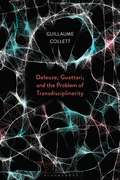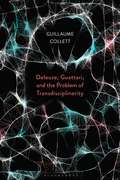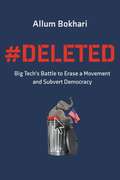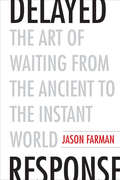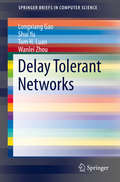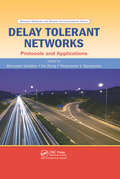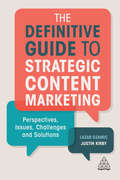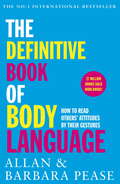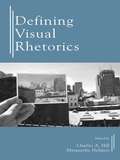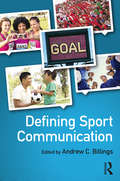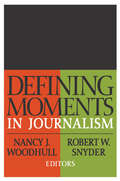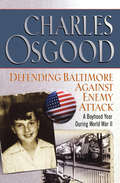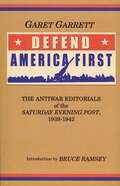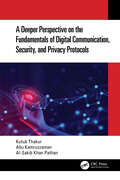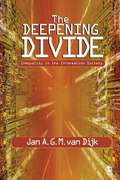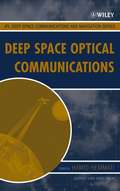- Table View
- List View
Delivering Data Analytics: A Step-By-Step Guide to Driving Adoption of Business Intelligence from Planning to Launch
by Nicholas KellyThe importance of data analytics is well known, but how can you get end users to engage with analytics and business intelligence (BI) when adoption of new technology can be frustratingly slow or may not happen at all? Avoid wasting time on dashboards and reports that no one uses with this practical guide to increasing analytics adoption by focusing on people and process, not technology. Pulling together agile, UX and change management principles, Delivering Data Analytics outlines a step-by-step, technology agnostic process designed to shift the organizational data culture and gain buy-in from users and stakeholders at every stage of the project. This book outlines how to succeed and build trust with stakeholders amid the politics, ambiguity and lack of engagement in business. With case studies, templates, checklists and scripts based on the author's considerable experience in analytics and data visualisation, this book covers the full cycle from requirements gathering and data assessment to training and launch. Ensure lasting adoption, trust and, most importantly, actionable business value with this roadmap to creating user-centric analytics projects.
Deliberative Polling®: Ein demoskopischer Ausweg aus der Krise der politischen Kommunikation?
by Eva Johanna SchweitzerEva Johanna Schweitzer untersucht am Beispiel einzelner in der Praxis durchgeführter Deliberative Pollings® Ansatz, Methode und Grenzen dieses Verfahrens mit Blick auf sein Potential, die Krise der politischen Kommunikation zu beenden.
Deleuze, Guattari, and the Problem of Transdisciplinarity
by Guillaume CollettDeleuze and Guattari's work has today become ubiquitous in the humanities and social sciences, being regularly drawn on by a vast array of subjects. Throughout their careers, Deleuze and Guattari also engaged with a myriad of disciplines; yet they declared themselves that “Philosophy is not interdisciplinary”. This apparent contradiction has rarely been explicitly confronted by scholars. Fortunately, however, Deleuze and Guattari left us a number of clues in their works signaling how to approach this apparent impasse. These clues amount to a complex and penetrating, if un-unified, theory of disciplinarity and cross-disciplinary articulation. Energized by recent developments in critical transdisciplinarity studies, this volume analyzes and evaluates instances of disciplinarity and transdisciplinarity within Deleuze and Guattari's shared and respective bodies of work. The first volume in English specifically devoted to examining Deleuze and Guattari's work using this framework, this book both contributes to the field of critical transdisciplinarity studies and in doing so helps shed light on the heart of Deleuze and Guattari's intellectual project.
Deleuze, Guattari, and the Problem of Transdisciplinarity
Deleuze and Guattari's work has today become ubiquitous in the humanities and social sciences, being regularly drawn on by a vast array of subjects. Throughout their careers, Deleuze and Guattari also engaged with a myriad of disciplines; yet they declared themselves that “Philosophy is not interdisciplinary”. This apparent contradiction has rarely been explicitly confronted by scholars. Fortunately, however, Deleuze and Guattari left us a number of clues in their works signaling how to approach this apparent impasse. These clues amount to a complex and penetrating, if un-unified, theory of disciplinarity and cross-disciplinary articulation. Energized by recent developments in critical transdisciplinarity studies, this volume analyzes and evaluates instances of disciplinarity and transdisciplinarity within Deleuze and Guattari's shared and respective bodies of work. The first volume in English specifically devoted to examining Deleuze and Guattari's work using this framework, this book both contributes to the field of critical transdisciplinarity studies and in doing so helps shed light on the heart of Deleuze and Guattari's intellectual project.
#DELETED: Big Tech's Battle to Erase the Trump Movement and Steal the Election
by Allum BokhariThe most powerful tech companies in the world are determined to stop Donald Trump. Journalist Allum Bokhari has spent four years investigating the tech giants that dominate the Internet: Google, Facebook, YouTube, Twitter. He has discovered a dark plot to seize control of the flow of information, and utilize that power to its full extent - to censor, manipulate, and ultimately sway the outcome of democratic elections. His network of whistleblowers inside Google, Facebook and other companies explain how the tech giants now see themselves as "good censors," benevolent commissars controlling the information we receive to "protect" us from "dangerous" speech. They reveal secret methods to covertly manipulate online information without us ever being aware of it, explaining how tech companies can use big data to target undecided voters. They lift the lid on a plot four years in the making - a plot to use the power of technology to stop Donald Trump's re-election.
Delayed Response: The Art of Waiting from the Ancient to the Instant World
by Jason FarmanA celebration of waiting throughout history, and of its importance for connection, understanding, and intimacy in human communication We have always been conscious of the wait for life†‘changing messages, whether it be the time it takes to receive a text message from your love, for a soldier’s family to learn news from the front, or for a space probe to deliver data from the far reaches of the solar system. In this book in praise of wait times, award†‘winning author Jason Farman passionately argues that the delay between call and answer has always been an important part of the message. Traveling backward from our current era of Twitter and texts, Farman shows how societies have worked to eliminate waiting in communication and how they have interpreted those times’ meanings. Exploring seven eras and objects of waiting—including pneumatic mail tubes in New York, Elizabethan wax seals, and Aboriginal Australian message sticks—Farman offers a new mindset for waiting. In a rebuttal to the demand for instant communication, Farman makes a powerful case for why good things can come to those who wait.
Delay Tolerant Networks (SpringerBriefs in Computer Science)
by Longxiang Gao Shui Yu Tom H. Luan Wanlei ZhouThis brief presents emerging and promising communication methods for network reliability via delay tolerant networks (DTNs). Different from traditional networks, DTNs possess unique features, such as long latency and unstable network topology. As a result, DTNs can be widely applied to critical applications, such as space communications, disaster rescue, and battlefield communications. The brief provides a complete investigation of DTNs and their current applications, from an overview to the latest development in the area. The core issue of data forward in DTNs is tackled, including the importance of social characteristics, which is an essential feature if the mobile devices are used for human communication. Security and privacy issues in DTNs are discussed, and future work is also discussed.
Delay Tolerant Networks: Protocols and Applications
by Athanasios V. Vasilakos Yan Zhang Thrasyvoulos SpyropoulosA class of Delay Tolerant Networks (DTN), which may violate one or more of the assumptions regarding the overall performance characteristics of the underlying links in order to achieve smooth operation, is rapidly growing in importance but may not be well served by the current end-to-end TCP/IP model. Delay Tolerant Networks: Protocols and Applicat
Delay Tolerant Networks: Protocols and Applications
by Yan Zhang Athanasios V. Vasilakos Thrasyvoulos SpyropoulosA class of Delay Tolerant Networks (DTN), which may violate one or more of the assumptions regarding the overall performance characteristics of the underlying links in order to achieve smooth operation, is rapidly growing in importance but may not be well served by the current end-to-end TCP/IP model. Delay Tolerant Networks: Protocols and Applicat
The Definitive Guide to Strategic Content Marketing: Perspectives, Issues, Challenges and Solutions
by Lazar Dzamic Justin KirbyMarketers everywhere are talking about content, but not everyone is saying the same thing. Some professionals love content and believe it has revolutionized the practice of marketing. To others, it's mere hype: a new name for what marketers have always done. The Definitive Guide to Strategic Content Marketing brings together all of these diverse perspectives, structuring them around useful key topics that provide insight into the multi-faceted nature of content marketing. The editors of The Definitive Guide to Strategic Content Marketing weave different voices together to present a balanced view of content marketing, grouping the discussion around relevant subjects such as content monetization, native advertising, visuals vs video, and the challenge of measuring results. This structure allows readers to move through the book according to their interests, and cherry-pick the most useful aspects of each discussion to apply to their own marketing initiatives. Containing contributions from, and interviews with, leading academics, industry experts, thought leaders and influencers, this book is a truly unique resource.
The Definitive Guide to Strategic Content Marketing: Perspectives, Issues, Challenges and Solutions
by Lazar Dzamic Justin KirbyMarketers everywhere are talking about content, but not everyone is saying the same thing. Some professionals love content and believe it has revolutionized the practice of marketing. To others, it's mere hype: a new name for what marketers have always done. The Definitive Guide to Strategic Content Marketing brings together all of these diverse perspectives, structuring them around useful key topics that provide insight into the multi-faceted nature of content marketing. The editors of The Definitive Guide to Strategic Content Marketing weave different voices together to present a balanced view of content marketing, grouping the discussion around relevant subjects such as content monetization, native advertising, visuals vs video, and the challenge of measuring results. This structure allows readers to move through the book according to their interests, and cherry-pick the most useful aspects of each discussion to apply to their own marketing initiatives. Containing contributions from, and interviews with, leading academics, industry experts, thought leaders and influencers, this book is a truly unique resource.
The Definitive Book of Body Language: How to read others’ attitudes by their gestures (Mira Ser.)
by Barbara Pease Allan PeaseThis international bestseller explains everything you need to know about body language, how to read it, and how to put your best self forwards.What people say is often very different to what they think or feel.Now, with THE DEFINITIVE BOOK OF BODY LANGUAGE, you can learn to read others people's thoughts by their gestures. It sounds implausible, but body language is easy to pick up and fun to use. Find out:How to tell if someone is lyingHow to make yourself likeableHow to get co-operation from other peopleHow to interview and negotiate successfullyHow to choose a partnerLearn the secrets of body language with Allan and Barbara Pease, bestselling authors of WHY MEN DON'T LISTEN AND WOMEN CAN'T READ MAPS.
Defining Visual Rhetorics
by Charles A. Hill Marguerite HelmersImages play an important role in developing consciousness and the relationship of the self to its surroundings. In this distinctive collection, editors Charles A. Hill and Marguerite Helmers examine the connection between visual images and persuasion, or how images act rhetorically upon viewers. Chapters included here highlight the differences and commonalities among a variety of projects identified as "visual rhetoric," leading to a more precise definition of the term and its role in rhetorical studies. Contributions to this volume consider a wide variety of sites of image production--from architecture to paintings, from film to needlepoint--in order to understand how images and texts work upon readers as symbolic forms of representation. Each chapter discusses, analyzes, and explains the visual aspect of a particular subject, and illustrates the ways in which messages and meaning are communicated visually. The contributions include work from rhetoric scholars in the English and communication disciplines, and represent a variety of methodologies--theoretical, textual analysis, psychological research, and cultural studies, among others. The editors seek to demonstrate that every new turn in the study of rhetorical practices reveals more possibilities for discussion, and that the recent "turn to the visual" has revealed an inexhaustible supply of new questions, problems, and objects for investigation. As a whole, the chapters presented here demonstrate the wide range of scholarship that is possible when a field begins to take seriously the analysis of images as important cultural and rhetorical forces. Defining Visual Rhetorics is appropriate for graduate or advanced undergraduate courses in rhetoric, English, mass communication, cultural studies, technical communication, and visual studies. It will also serve as an insightful resource for researchers, scholars, and educators interested in rhetoric, cultural studies, and communication studies.
Defining Visual Rhetorics
by Charles A. Hill Marguerite HelmersImages play an important role in developing consciousness and the relationship of the self to its surroundings. In this distinctive collection, editors Charles A. Hill and Marguerite Helmers examine the connection between visual images and persuasion, or how images act rhetorically upon viewers. Chapters included here highlight the differences and commonalities among a variety of projects identified as "visual rhetoric," leading to a more precise definition of the term and its role in rhetorical studies. Contributions to this volume consider a wide variety of sites of image production--from architecture to paintings, from film to needlepoint--in order to understand how images and texts work upon readers as symbolic forms of representation. Each chapter discusses, analyzes, and explains the visual aspect of a particular subject, and illustrates the ways in which messages and meaning are communicated visually. The contributions include work from rhetoric scholars in the English and communication disciplines, and represent a variety of methodologies--theoretical, textual analysis, psychological research, and cultural studies, among others. The editors seek to demonstrate that every new turn in the study of rhetorical practices reveals more possibilities for discussion, and that the recent "turn to the visual" has revealed an inexhaustible supply of new questions, problems, and objects for investigation. As a whole, the chapters presented here demonstrate the wide range of scholarship that is possible when a field begins to take seriously the analysis of images as important cultural and rhetorical forces. Defining Visual Rhetorics is appropriate for graduate or advanced undergraduate courses in rhetoric, English, mass communication, cultural studies, technical communication, and visual studies. It will also serve as an insightful resource for researchers, scholars, and educators interested in rhetoric, cultural studies, and communication studies.
Defining Sport Communication
by Andrew C. BillingsDefining Sport Communication is a comprehensive resource addressing core topics and issues, including humanistic, organizational, relational, and mediated approaches to the study of sport communication. It provides foundational work in sport communication for students and scholars, reflecting the abundance of research published in recent years and the ever-increasing interest in this area of study. Bringing together scholars from various epistemological viewpoints within communication, this volume provides a unique opportunity for defining the breadth and depth of sport communication research. It will serve as a seminal reference for existing scholarship while also providing an agenda for future research.
Defining Sport Communication
by Andrew C. BillingsDefining Sport Communication is a comprehensive resource addressing core topics and issues, including humanistic, organizational, relational, and mediated approaches to the study of sport communication. It provides foundational work in sport communication for students and scholars, reflecting the abundance of research published in recent years and the ever-increasing interest in this area of study. Bringing together scholars from various epistemological viewpoints within communication, this volume provides a unique opportunity for defining the breadth and depth of sport communication research. It will serve as a seminal reference for existing scholarship while also providing an agenda for future research.
Defining Moments in Journalism
by Nancy J. Woodhull Robert W. SnyderMost great transformations are not apparent as we live through them. Only in hindsight do individual moments acquire layers of meaning that give them great significance. Looking back is not something that comes naturally to journalists, immersed as they are in breaking events and relentless deadlines. But there is still good reason for journalists, scholars, and people who care about journalism to think about the critical episodes in its recent evolution. In Defining Moments in Journalism, such authors vividly describe episodes of this kind. Some of the chapters and contributors include: "The Lessons of Little Rock" by Harry S. Ashmore; "Vietnam and War Reporting" by Peter Arnett; "Photo-journalists--Visionaries Who Have Changed Our Vision" by Jane M. Rosett; "The Weight of Watergate" by Ellen Hume; "Women Sportswriters--Business as Usual" by Mary Schmitt; "The Connie Chung Phenomenon" by Somini Sengupta; and "Covering Politics--Is There a Female Difference?" by Judy Woodruff. The years since the Great Depression and World War II have seen vast changes in America and also in its journalism. Journalists' relationship to power and authority is more complex; the press corps has become more diverse; the technology of news reporting is almost unrecognizably different from that of fifty years ago; and economic reorganization of the media has bundled news and entertainment organizations into conglomerates of extraordinary size. 'Defining Moments in Journalism' is a fascinating read for communications scholars and professionals, historians, and political scientists.
Defining Moments in Journalism
by Nancy J. Woodhull Robert W. SnyderMost great transformations are not apparent as we live through them. Only in hindsight do individual moments acquire layers of meaning that give them great significance. Looking back is not something that comes naturally to journalists, immersed as they are in breaking events and relentless deadlines. But there is still good reason for journalists, scholars, and people who care about journalism to think about the critical episodes in its recent evolution. In Defining Moments in Journalism, such authors vividly describe episodes of this kind. Some of the chapters and contributors include: "The Lessons of Little Rock" by Harry S. Ashmore; "Vietnam and War Reporting" by Peter Arnett; "Photo-journalists--Visionaries Who Have Changed Our Vision" by Jane M. Rosett; "The Weight of Watergate" by Ellen Hume; "Women Sportswriters--Business as Usual" by Mary Schmitt; "The Connie Chung Phenomenon" by Somini Sengupta; and "Covering Politics--Is There a Female Difference?" by Judy Woodruff. The years since the Great Depression and World War II have seen vast changes in America and also in its journalism. Journalists' relationship to power and authority is more complex; the press corps has become more diverse; the technology of news reporting is almost unrecognizably different from that of fifty years ago; and economic reorganization of the media has bundled news and entertainment organizations into conglomerates of extraordinary size. 'Defining Moments in Journalism' is a fascinating read for communications scholars and professionals, historians, and political scientists.
Defending Baltimore Against Enemy Attack: A Boyhood Year During World War II
by Charles OsgoodFrom beloved broadcaster Charles Osgood, a poignant memoir about one unforgettable childhood year during World War II. Defending Baltimore Against Enemy Attack is a gloriously funny and nostalgic slice of American life and a moving look at World War II from the perspective of a child far away from the fighting, but very conscious of the reverberations. With a sharp eye for details, Osgood captures the texture of life in a bygone era.
Defending Baltimore Against Enemy Attack: A Boyhood Year During World War II
by Charles OsgoodFrom beloved broadcaster Charles Osgood, a poignant memoir about one unforgettable childhood year during World War II.Defending Baltimore Against Enemy Attack is a gloriously funny and nostalgic slice of American life and a moving look at World War II from the perspective of a child far away from the fighting, but very conscious of the reverberations. With a sharp eye for details, Osgood captures the texture of life in a bygone era.
Defend America First: The Antiwar Editorials Of The Saturday Evening Post, 1939-1942
by Garet Garrett Bruce RamseyA Deeper Perspective on the Fundamentals of Digital Communication, Security, and Privacy Protocols
by Kutub Thakur Abu Kamruzzaman Al-Sakib Khan PathanThis book, divided into three parts, describes the detailed concepts of Digital Communication, Security, and Privacy protocols. In Part One, the first chapter provides a deeper perspective on communications, while Chapters 2 and 3 focus on analog and digital communication networks. Part Two then delves into various Digital Communication protocols. Beginning first in Chapter 4 with the major Telephony protocols, Chapter 5 then focuses on important Data Communication protocols, leading onto the discussion of Wireless and Cellular Communication protocols in Chapter 6 and Fiber Optic Data Transmission protocols in Chapter 7. Part Three covers Digital Security and Privacy protocols including Network Security protocols (Chapter 8), Wireless Security protocols (Chapter 9), and Server Level Security systems (Chapter 10), while the final chapter covers various aspects of privacy related to communication protocols and associated issues. This book will offer great benefits to graduate and undergraduate students, researchers, and practitioners. It could be used as a textbook as well as reference material for these topics. All the authors are well-qualified in this domain. The authors have an approved textbook that is used in some US, Saudi, and Bangladeshi universities since Fall 2020 semester – although used in online lectures/classes due to COVID-19 pandemic.
A Deeper Perspective on the Fundamentals of Digital Communication, Security, and Privacy Protocols
by Kutub Thakur Abu Kamruzzaman Al-Sakib Khan PathanThis book, divided into three parts, describes the detailed concepts of Digital Communication, Security, and Privacy protocols. In Part One, the first chapter provides a deeper perspective on communications, while Chapters 2 and 3 focus on analog and digital communication networks. Part Two then delves into various Digital Communication protocols. Beginning first in Chapter 4 with the major Telephony protocols, Chapter 5 then focuses on important Data Communication protocols, leading onto the discussion of Wireless and Cellular Communication protocols in Chapter 6 and Fiber Optic Data Transmission protocols in Chapter 7. Part Three covers Digital Security and Privacy protocols including Network Security protocols (Chapter 8), Wireless Security protocols (Chapter 9), and Server Level Security systems (Chapter 10), while the final chapter covers various aspects of privacy related to communication protocols and associated issues. This book will offer great benefits to graduate and undergraduate students, researchers, and practitioners. It could be used as a textbook as well as reference material for these topics. All the authors are well-qualified in this domain. The authors have an approved textbook that is used in some US, Saudi, and Bangladeshi universities since Fall 2020 semester – although used in online lectures/classes due to COVID-19 pandemic.
The Deepening Divide: Inequality in the Information Society (PDF)
by Dijk, Jan A. G. M. vanDuring the mid 90's, around the time the Internet became popular, it became apparent that there was still one critical issue holding back limitless opportunities. Computer professionals had to find a way to close the gap between those who do not have computer or Internet access and those who do, also known as the digital divide. Suddenly, hundreds of conferences of computer professionals, social scientists, and government policy experts worldwide dedicated themselves to this concern. Then the Internet hype seemed to dissipate, and observers assumed the digital divide would fix itself. The Deepening Divide explains why the digital divide is still widening and, in advanced high-tech societies, deepening. Taken from an international perspective, the book offers full coverage of the literature and research and a theoretical framework from which to analyze and approach the issue. Where most books on the digital divide only describe and analyze the issue, Jan van Dijk presents 26 policy perspectives and instruments designed to close the divide itself.
Deep Space Optical Communications (JPL Deep-Space Communications and Navigation Series #11)
by Hamid HemmatiA quarter century of research into deep space and near Earth optical communications This book captures a quarter century of research and development in deep space optical communications from the Jet Propulsion Laboratory (JPL). Additionally, it presents findings from other optical communications research groups from around the world for a full perspective. Readers are brought up to date with the latest developments in optical communications technology, as well as the state of the art in component and subsystem technologies, fundamental limitations, and approaches to develop and fully exploit new technologies. The book explores the unique requirements and technologies for deep space optical communications, including: * Technology overview; link and system design drivers * Atmospheric transmission, propagation, and reception issues * Flight and ground terminal architecture and subsystems * Future prospects and applications, including navigational tracking and light science This is the first book to specifically address deep space optical communications. With an increasing demand for data from planetary spacecraft and other sources, it is essential reading for all optical communications, telecommunications, and system engineers, as well as technical managers in the aerospace industry. It is also recommended for graduate students interested in deep space communications.
